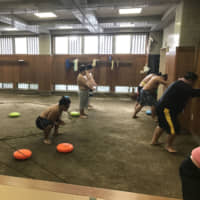Sumo is often described as a lifestyle rather than a sport.
As regimented as a military and requiring the total immersion of a religious order, it's certainly much more multifaceted than any other activity that makes the sports section of this paper.
For many in sumo, the daily ritual of keiko (training) is one of the most important parts of being a rikishi. It's a practice that has intrinsic value and not just a means to an end.
That's a major reason that there is little variance in the routine from one morning to the next.
While each stable has its own pattern, the basics are the same and the overall flow of the elements is identical.
Sumo is a sport, however, and that means rikishi, especially more recent generations, have increasingly become more scientific in their approach to training.
Sumo is still years behind sports like rugby or American football, where athletes have highly specialized programs that control almost every aspect of their lives including diet, sleep and training, but it is changing.
Lifting weights or going to a gym was once frowned upon as there was a widespread belief in sumo circles that building muscular bodies made wrestlers stiff and tight and unsuited for the sport.
Nowadays you can see younger rikishi teaming up with athletes from other sports and incorporating different methods and ideas into their own training.
Terunofuji and some other wrestlers have tried CrossFit, Ishiura often trains with MMA fighters, and Hidenoumi is a regular at a kaatsu gym run by former komusubi Kaiho.
Tamanoi stable has probably gone the furthest by bringing outside trainers in to go through exercise programs after the conclusion of regular keiko.


















With your current subscription plan you can comment on stories. However, before writing your first comment, please create a display name in the Profile section of your subscriber account page.